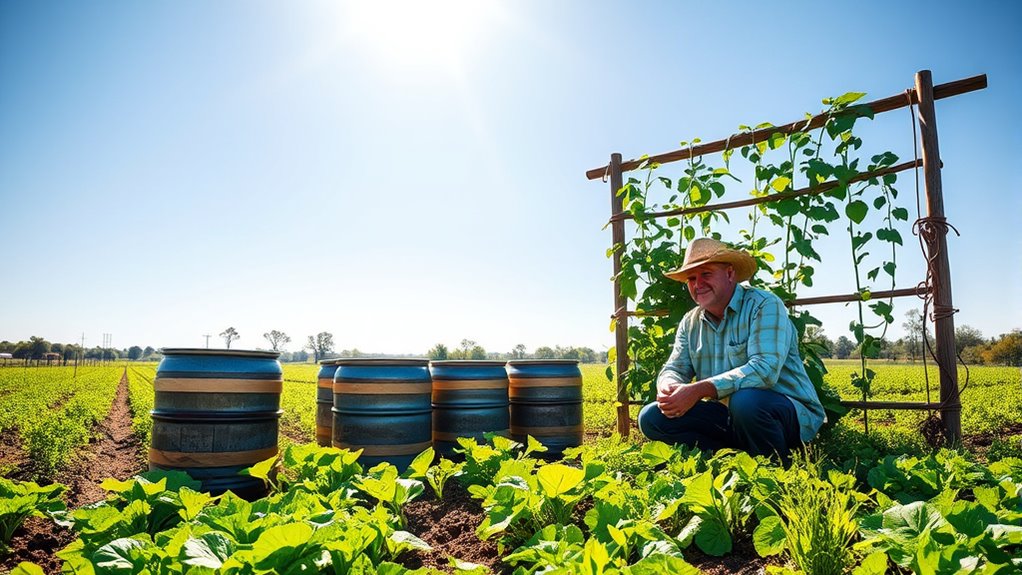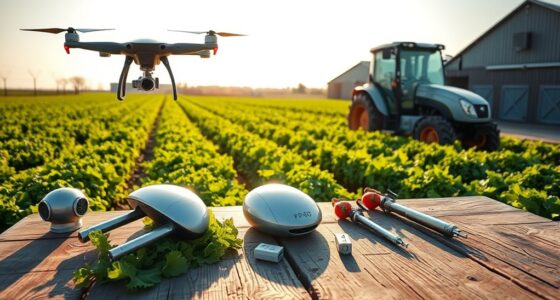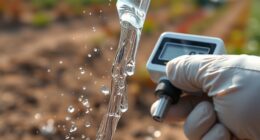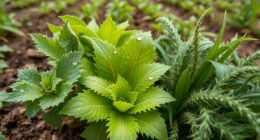DIY rainwater harvesting for small farms is a smart way to collect and use water sustainably. Start by choosing a catchment surface, like a roof, and set up gutters and downspouts to direct rainwater into storage. Use first flush diverters and filtration systems to keep your water clean. Make sure to maintain your setup regularly to prevent algae growth and clogs. With proper management, rainwater can enhance your crop health. There's more to discover about optimizing your system!
Key Takeaways
- Assess your roof size to estimate potential rainwater yield, targeting around 0.623 gallons per square foot per inch of rainfall.
- Install first flush diverters to discard initial runoff, improving water quality for irrigation purposes.
- Choose appropriate storage solutions, like food-grade barrels or IBC totes, ensuring they are opaque to minimize algae growth.
- Incorporate filtration systems with 30-micron screens to remove debris and maintain regular cleaning schedules for optimal flow.
- Implement gravity feed systems for efficient water delivery, or select energy-efficient pumps for enhanced irrigation support, especially in remote areas.
Understanding Rainwater Harvesting

Rainwater harvesting is a practical way to collect and store runoff from surfaces like roofs, helping you cut down on your reliance on municipal water sources for irrigation and other nonpotable uses.
By setting up rainwater collection systems, you can efficiently gather water, boosting your sustainability efforts. A key component is the first flush diverter, which discards the initial runoff that may carry contaminants, ensuring better water quality.
Setting up rainwater collection systems enhances sustainability by efficiently gathering water while ensuring quality through first flush diverters.
You'll also need rainwater storage tanks to hold the collected water for future use. Remember, regular maintenance is essential to prevent issues like algae growth.
Finally, don't forget to check local legal considerations regarding rainwater harvesting systems, as regulations can vary greatly by region, impacting your ability to collect and utilize this resource.
Components of a Rainwater Collection System
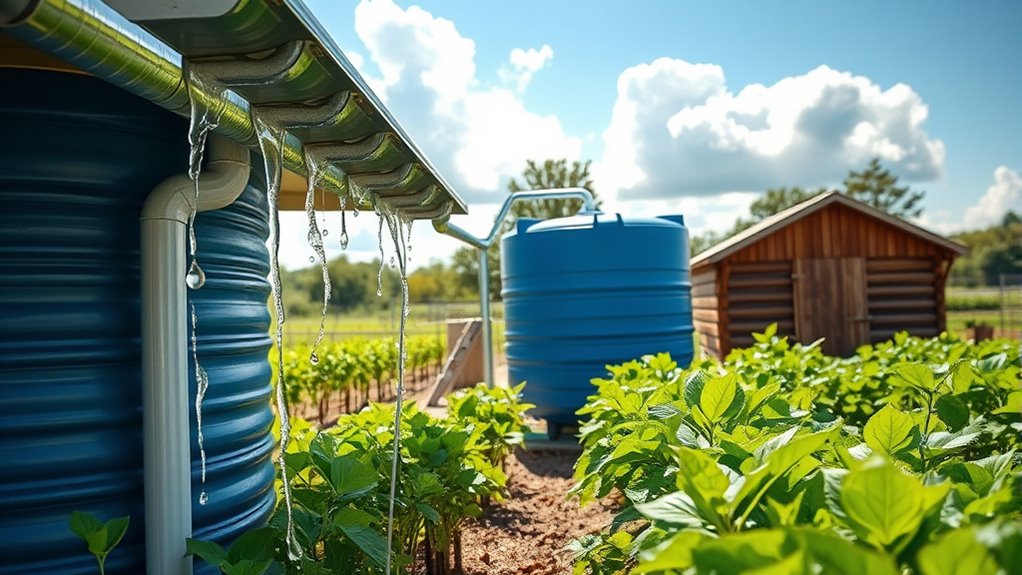
A rainwater collection system consists of several key components that work together to efficiently gather and store water. The process begins with a catchment surface, like a roof, directing rainfall into gutters and downspouts. Proper maintenance of gutters is essential to prevent clogs. First flush diverters discard the initial runoff, enhancing water quality by removing contaminants.
| Component | Description |
|---|---|
| Catchment Surface | Roof collecting rainwater |
| First Flush Diverters | Discard initial runoff |
| Filtration Elements | Sediment pre-filters, fine mesh screens |
| Storage Options | Decorative barrels, food-grade drums, IBC totes |
| Water Quality | Guaranteed through filtration and diverters |
Selecting the right components guarantees your rainwater collection system operates effectively and safely.
Selecting the Right Collection Surface
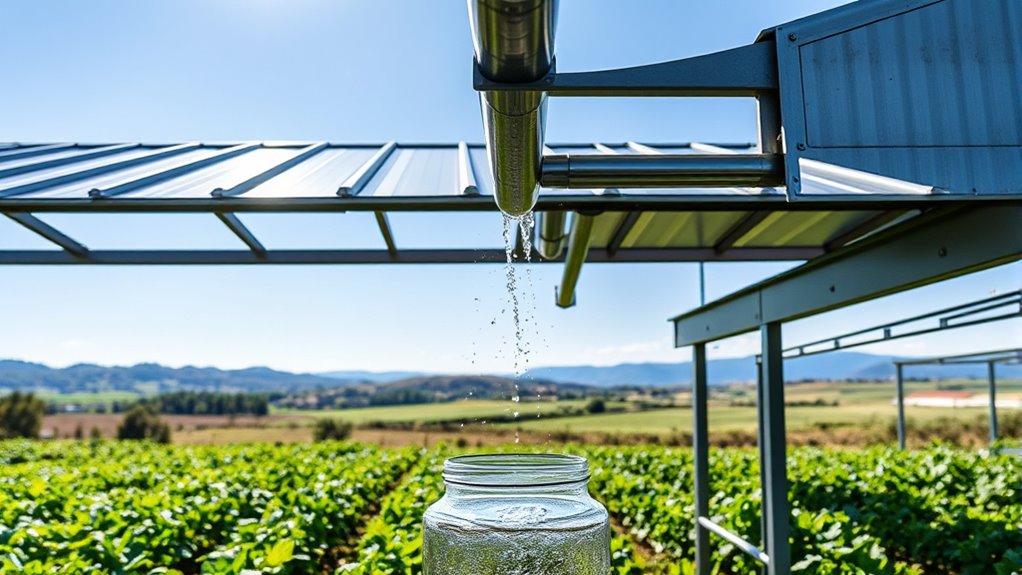
When setting up your rainwater harvesting system, selecting the right collection surface is essential for maximizing efficiency and ensuring water quality.
Roofs are the most common collection surfaces, with metal roofs yielding cleaner water than asphalt shingles, which can trap debris. The size of your roof area impacts the volume of water you can harvest; for example, a 1,000 square foot roof can collect around 600 gallons from just one inch of rain.
Make sure your collection surface is clean and free of debris, as contaminants can harm water quality. Additionally, properly designed gutters and downspouts will help direct the rainwater efficiently to your storage system, preventing overflow and clogs while optimizing flow.
Importance of Filtration and Maintenance
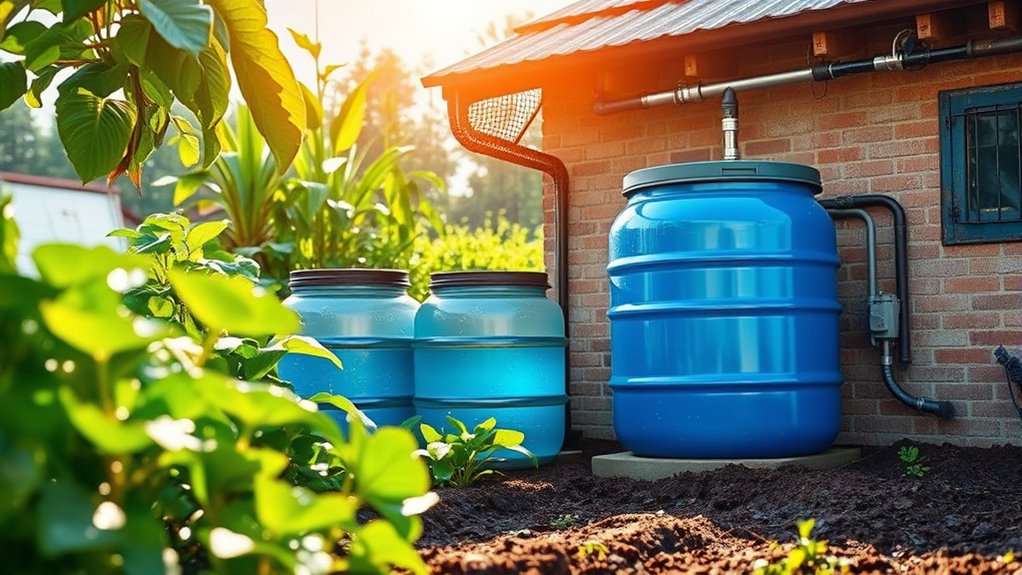
Proper filtration and regular maintenance are vital for guaranteeing your rainwater harvesting system remains efficient and safe.
Start by using a first flush diverter to discard initial runoff, which often contains pollutants. This way, only cleaner water enters your storage tank.
Utilize a first flush diverter to eliminate initial runoff, ensuring only cleaner water fills your storage tank.
To maintain high water quality, install primary filters with 30-micron screens to remove debris effectively. You should clean these filters monthly to prevent clogging and guarantee peak flow.
Additionally, keep your storage tank opaque and covered to minimize algae growth, and aim for yearly cleanings to eliminate sediment.
Regularly monitoring and maintaining the entire filtration system is essential; neglect can lead to contamination and reduced efficiency in your water collection and usage.
Designing Your Storage System
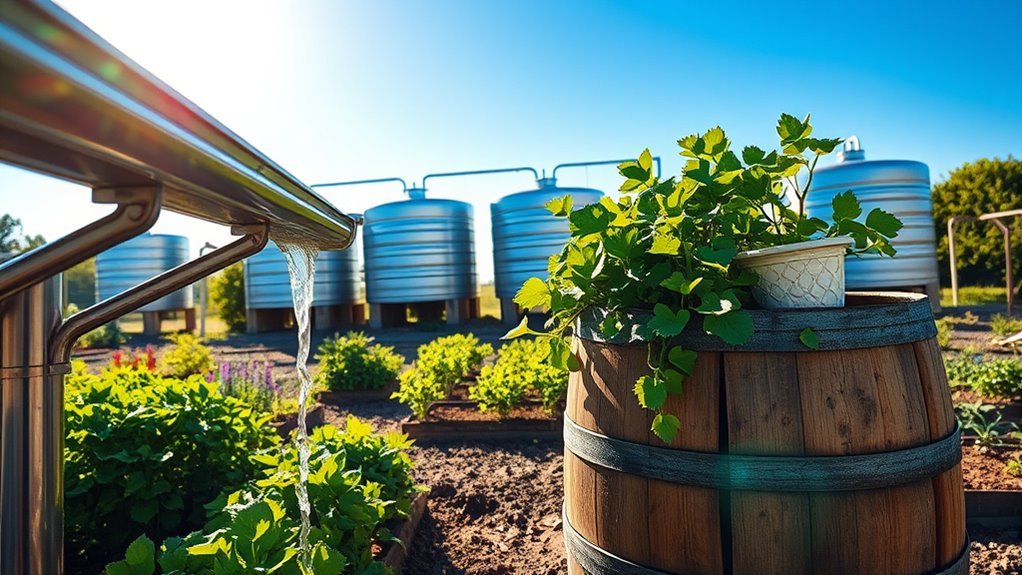
Designing an effective rainwater storage system is crucial for maximizing your water collection efforts. Start by calculating your potential rainwater collection using your roof area and rainfall data. Choose suitable rainwater storage tanks, like food-grade IBC totes, which hold 275-330 gallons. Confirm they're opaque to prevent algae growth. Incorporate a first flush diverter to discard initial runoff contaminants and maintain water quality. Your downspout configuration should efficiently channel water from gutters into the storage tanks. Regular maintenance, including cleaning filters and inspecting for leaks, is essential for peak functionality. Additionally, understanding common fees associated with Gold IRAs can help you budget for the costs of setting up and maintaining your rainwater system.
| Component | Purpose | Recommendations |
|---|---|---|
| Rainwater Storage Tank | Store collected rainwater | Use IBC totes |
| First Flush Diverter | Remove contaminants | Install before tank |
| Downspout Configuration | Direct water flow | Optimize placement |
| Maintenance | Confirm water quality | Clean and inspect regularly |
Seasonal Management of Collected Water
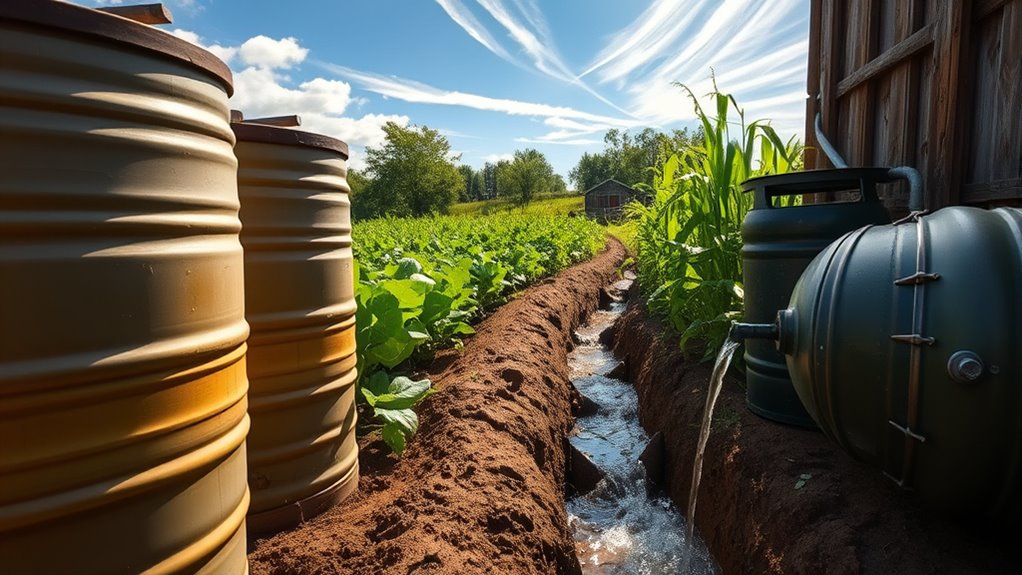
As you manage your rainwater collection, you'll want to maximize usage in the summer while ensuring safe diversion in the winter.
By installing a Downspout Diverter, you can direct water into your system during the warmer months and prevent freezing damage when temperatures drop.
Regular maintenance of your filtration system is essential, especially during autumn when leaves can clog your setup.
Summer Water Utilization
While summer brings warmer weather and an increased demand for water, it also offers a perfect opportunity to utilize collected rainwater for irrigation.
By implementing a downspout diverter, you can efficiently direct rainwater from your gutter system into your storage tank, effectively managing summer water demands. A properly sized tank, like a 300-gallon IBC tote, guarantees you have enough water for your crops.
Regular maintenance, including gutter strainers, prevents debris from blocking flow, maximizing your rainwater collection efficiency.
To distribute the water, consider using gravity feed or a pump system; a ½ HP pump is ideal for pushing water uphill as needed, guaranteeing your irrigation systems run smoothly throughout the hot months.
Winter Water Diversion
To effectively manage your rainwater system during the winter months, it's crucial to implement a Downspout Diverter that redirects collected rainwater away from your storage tanks. This winter water diversion prevents freezing, which can damage your system.
Verify you have a Gutter Strainer in place to block large debris from clogging your gutters and downspouts, maintaining peak flow during winter rains. Additionally, don't forget the First Flush system; it filters out initial runoff contaminants, improving water quality.
Regularly inspect your system to confirm that the downspouts and diverters are functioning properly. This proactive approach prevents ice buildup and overflow issues, allowing your rainwater collection system to operate efficiently, even in the coldest months.
Filtration System Maintenance
With winter water diversion measures in place, you can now focus on keeping your filtration system in prime condition.
Start by regularly cleaning filter screens and first flush diverters every month to maintain peak water quality and prevent clogging.
In winter, make sure you divert water to ground drainage to avoid freezing in your system.
Use a gutter strainer to keep large debris out, making it easier to manage smaller contaminants during maintenance.
Inspect and replace primary filters, like 30-micron filters in roof washers, every few months based on water quality.
Finally, monitor your tank conditions for algae growth and sediment build-up at least once a year to guarantee the longevity and safety of your collected water.
Utilizing Collected Rainwater
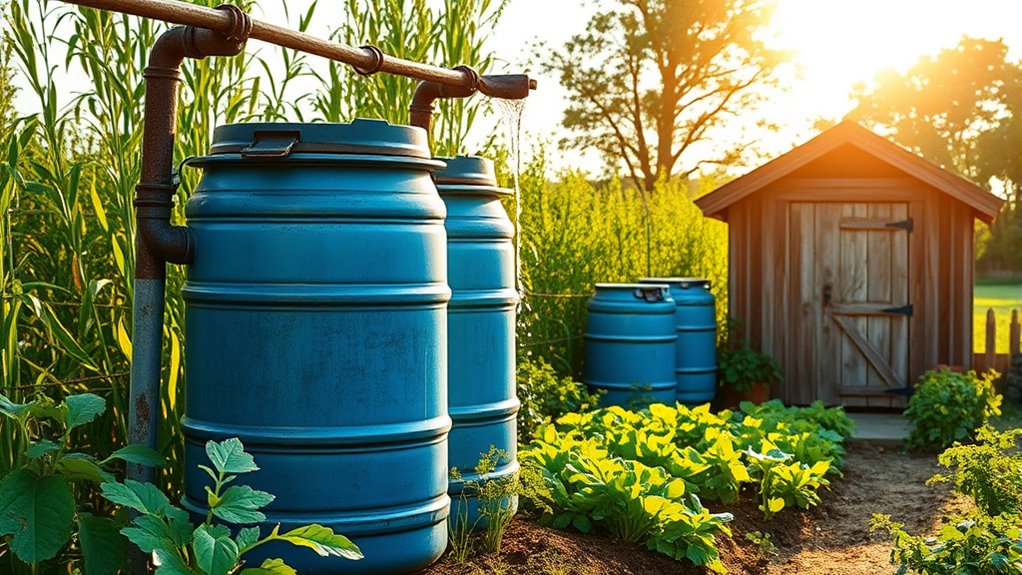
Utilizing collected rainwater can greatly benefit your garden and landscape, as it provides a sustainable and eco-friendly irrigation solution. By capturing rainwater, you reduce dependence on municipal sources, while enhancing your plants' health due to the absence of chlorine and other contaminants found in tap water.
A well-designed rainwater collection system can yield about 0.623 gallons for every square foot of roof area per inch of rain, allowing you to plan effectively based on local rainfall patterns. To guarantee the quality of stored rainwater, incorporate filtration systems and first flush diverters to remove debris.
Regular maintenance of storage tanks and filters is essential, helping you maximize the efficiency and safety of your irrigation practices. Additionally, integrating rainwater harvesting with solar energy solutions can further enhance your farm's sustainability by reducing reliance on conventional power sources for pumping and irrigation.
Enhancing Your System With Pumps and Delivery

To enhance your rainwater harvesting system, you'll want to focus on pump selection, gravity feed advantages, and maintenance best practices.
Choosing the right pump can make all the difference in delivering water efficiently, while gravity feed can help you save energy.
Don't forget that regular maintenance is key to keeping your system running smoothly and preventing clogs.
Pump Selection Criteria
Choosing the right pump is essential for optimizing your DIY rainwater harvesting system. Start by evaluating the pump selection criteria, focusing on the required flow rate (GPH) based on how high and far you need to move the water.
A ½ HP pump is often suitable for pushing water uphill, but adjust the size according to your specific setup. Make certain the pump is self-priming and rated for rainwater use to prevent damage, especially when your tank's low.
Adding a filter with a 3 to 5-micron rating before the pump will protect it from debris. For energy efficiency, consider solar-powered pumps, particularly in remote areas where electricity access might be an issue.
Gravity Feed Advantages
While pumps are essential for certain scenarios, a gravity feed system can simplify your rainwater harvesting setup by using natural forces to deliver water efficiently.
By elevating storage tanks at least 2 feet, you notably boost water pressure, often meeting the 20 psi needed for standard drip irrigation systems. This low-energy method minimizes costs and maintenance.
Consider these benefits of gravity feed systems:
- Cost-effective: Reduces energy use compared to pumps.
- Low maintenance: Fewer moving parts mean less upkeep.
- Sustainable: Utilizes natural gravity for water delivery.
Incorporating gravity feed systems in your rainwater harvesting systems can enhance efficiency, providing reliable water delivery to your crops or livestock.
Maintenance Best Practices
Maintaining your rainwater harvesting system is essential for ensuring its efficiency and longevity. Start by cleaning filter screens and pre-filters at least once a month. This prevents clogs and keeps your water quality high.
Implement an on-demand pump with pressure maintenance for consistent water delivery without fluctuations. After the pump, install a sediment filter with a 3 to 5-micron rating to protect it from debris.
Regularly monitor water levels using gauges or wireless indicators to avoid running dry. Don't forget to conduct annual inspections of your rainwater storage containers, piping, and pump systems to check for leaks or cracks.
Following these best practices will help you maintain peak performance and extend the lifespan of your system.
Community and Environmental Benefits
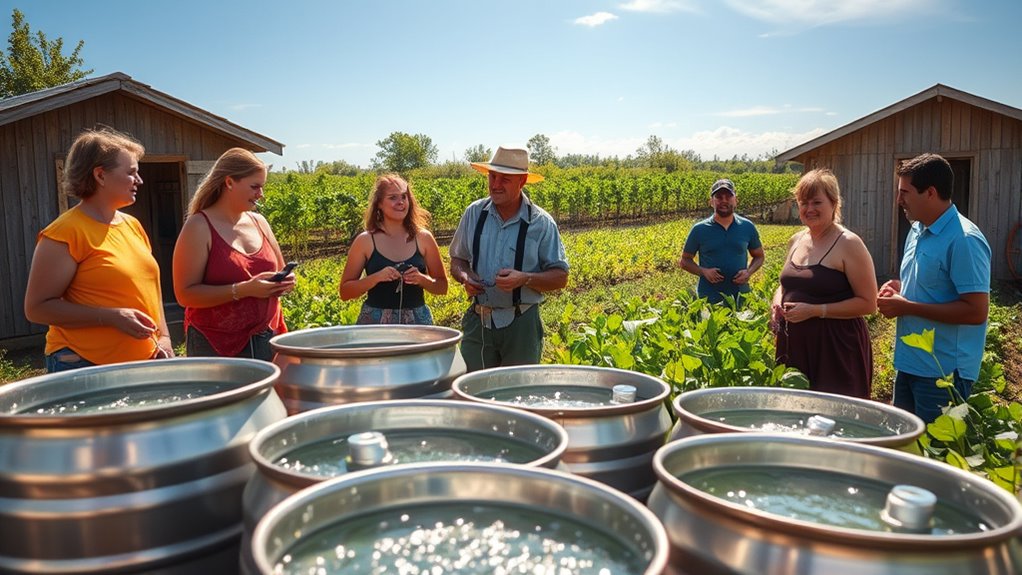
Implementing DIY rainwater harvesting systems not only benefits individual farmers but also fosters community resilience and environmental health.
By collecting rainwater, you can markedly reduce reliance on municipal water sources, creating a sustainable water supply for your irrigation needs. This practice helps mitigate stormwater runoff, protecting local watersheds and reducing soil erosion.
- Promotes self-sufficiency by providing a reliable water source, especially during drought.
- Improves plant health with chemical-free water, leading to better growth and nutrient uptake.
- Contributes to environmental sustainability, lowering your farm's overall ecological footprint. Airless sprayers can also be used to efficiently apply treatments to crops and maintain optimal growth conditions.
Frequently Asked Questions
Is It Legal to Collect Your Own Rainwater?
Whether it's legal to collect your own rainwater depends on where you live.
In some states, it's encouraged, while others have strict regulations or permits you must obtain.
You'll want to check local laws to confirm you comply, as some areas limit how much water you can collect or require registration of your system.
Always verify the rules in your region to avoid fines and confirm you're following the right guidelines.
Which Is the Cheapest Method of Rainwater Harvesting?
When life hands you rain, you might as well catch it!
The cheapest method of rainwater harvesting involves simple rain barrels, which can cost between $50 and $100. If you're feeling resourceful, you can even create DIY barrels from repurposed food-grade containers.
With just a roof, gutters, downspouts, and a barrel, you can set up an efficient system without breaking the bank. Just remember to maintain it for the best results!
How Do You Keep Rain Water From Stagnating?
To keep rainwater from stagnating, you'll want to take several proactive steps.
First, place your storage tanks in shaded areas to minimize UV exposure, which promotes algae growth.
Regularly inspect and clean your collection system to prevent debris buildup.
Using opaque, covered tanks helps limit light penetration.
Implement a first flush diverter to discard initial runoff.
Finally, make certain your tanks have mosquito-tight seals to deter pests and maintain water quality.
What Are the 10 Disadvantages of Rainwater Harvesting?
You might think rainwater harvesting is the holy grail of water solutions, but it's packed with pitfalls!
First, it can hit your wallet hard with installation costs. Then, there's the hassle of filtration and treatment, which adds ongoing expenses.
Unpredictable rainfall can leave you high and dry. Plus, you'll need space for tanks, and legal restrictions might throw a wrench in your plans.
All these factors could make you rethink your water strategy!
Conclusion
By embracing DIY rainwater harvesting, you're not just saving water; you're cultivating a sustainable future for your farm and community. Think of it as a lifeline, nourishing your crops while reducing your reliance on traditional water sources. With a little effort and creativity, you can transform every drop of rain into a valuable resource. So, roll up your sleeves, start building your system, and watch your farm flourish as you harness nature's bounty!

